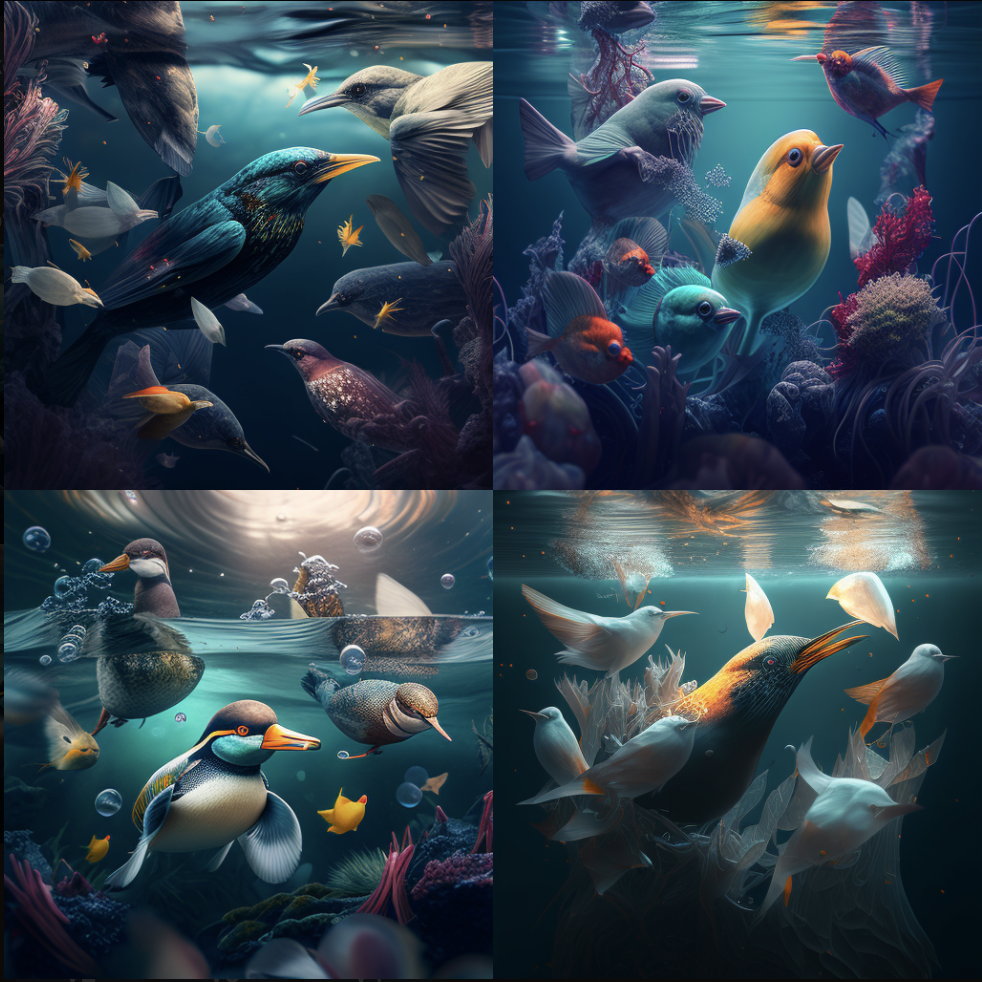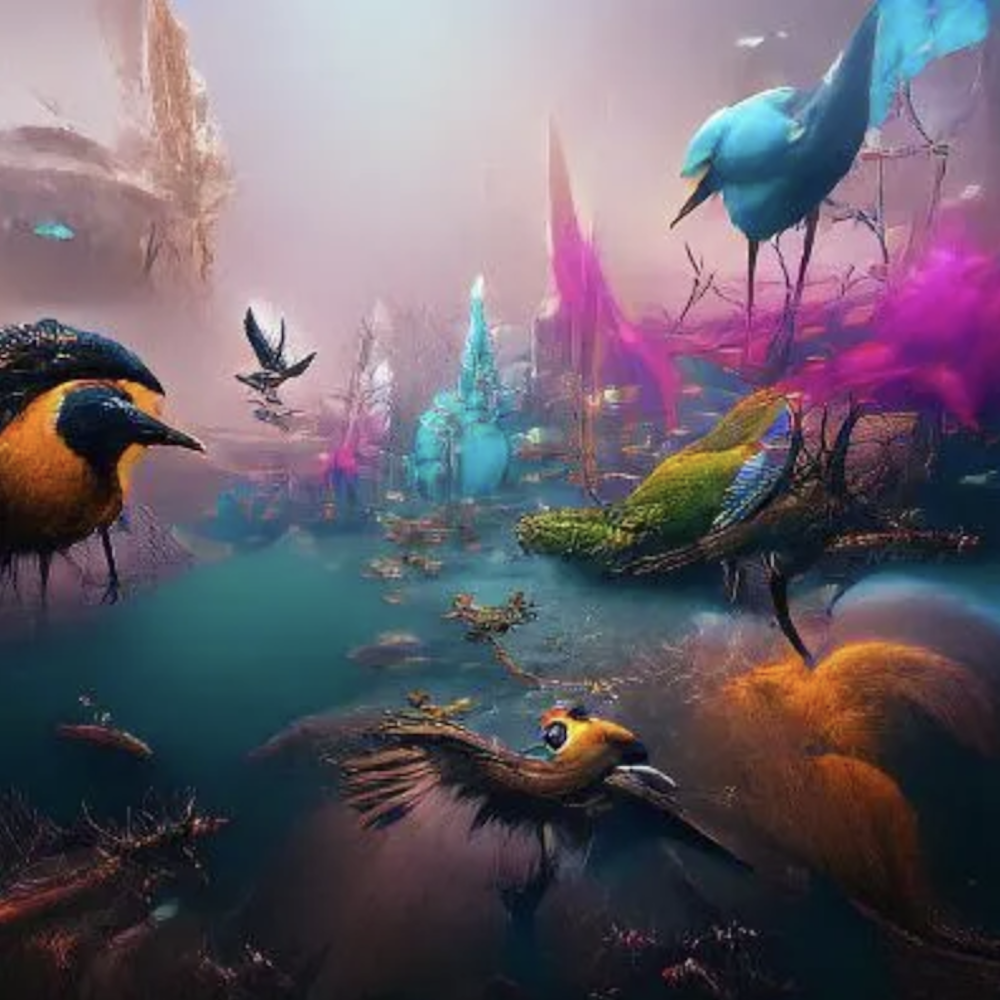What is AI generated art and how does it work?
We have seen a rise in the popularity of AI generated art and content in the past couple of months. Whether it be creating multiple styles of fantasy profiles of yourself on social media, magically writing an essay for your literature class, or typing a prompt that produces an image of birds flying underwater, AI seems to be seeping into the art world seamlessly.
Technology is constantly blurring the lines between reality and the digital space, Generative Art should definitely have a seat at the table. This type of technology seems like the “future” they referred to in the 70s.
To further understand the AI space as it stands right now, I decided to dabble in this experimental art form and see what I could create and how accurate it would be.


The prompt I used was; a world of birds underwater
I tested out 2 apps to get a feel of how to create AI generated art; the first, a free online AI generated art website (Night Cafe) that categorises styles and types of algorithms, to help the creator come up with artworks that are specifically curated for the creator and their vision. This tool is a good place to start, although the final artworks are a little vague and amateur looking, it trains the creator to refine their prompt skills, provides free credits to generate artworks every day and the creator can evolve artworks they have created. The second, Midjourney, is an AI system on a Discord server that uses a bot to help you generate art in real time. This system runs a lot smoother, since it works on Discord, you are constantly bombarded with new artworks by other creators in the community (which can serve as instant inspiration) and the results seem more well thought out, detailed and accurate in adherence to the prompts.
So, how does it work? (A brief explanation)
The algorithm is fed millions of reference images (of artworks, art styles, objects, places, etc.) The algorithm allows the computer to learn the aesthetic of the references that have been fed by analysing them. Once the system gets a text prompt (input) from the artist, it generates an image that adheres to the prompt. The outcome is a blend of all the relevant visual representations from the references.
This can be compared to the process of a translator translating a show word for word. We cannot sense the sarcasm, fear or other emotions that are veiled behind empty words. The translated dialogue at this point lacks nuances that create emotions, and can change or lose the intent behind the words said. Having said that, advanced systems are coming quite close to recreating poses and facial features that portray emotions, making it harder to tell AI art and “real” art apart at first glance.
The 2 things that instantly pop into mind are; Can this be considered art?
And, I can finally explain my dreams!
So let’s get into it; Can this be considered art?
The short answer? Yes
There is no gatekeeping. Art is and will always be subjective. Art can never be just one thing, it takes many forms, it is ever changing and it is what you make of it. I have seen some amazing works online by really talented artists/ AI agents.
In 2018, Christie’s sold its first art created by an algorithm, “Portrait of Edmond Belamy, sold for an incredible $432,500” created by Obvious, a Paris-based collective consisting of Hugo Caselles-Dupré, Pierre Fautrel and Gauthier Vernier.
This was the first real introduction of AI art to the world auction stage, with the biggest take away being, “algorithms are able to emulate creativity,” as stated by Hugo Caselles-Dupré.
Keeping this in mind, the definition of Conceptual Art best supports this argument; “art in which the idea or concept presented by the artist is considered more important than its appearance or execution.” We can all agree that a computer cannot create art on its own without the help or guidance of a human. The creator’s intention of creating a specific work is what drives this type of art. Generative art also evokes a reaction from the viewer. There will always be a lot of dialogue surrounding the artwork.
Why is it such a debate then?
As visually aesthetic as Generative Art can be, it has received a lot of resistance from the community. The main point of contention is whether AI creators can truly be referred to as artists, because people argue that an artist is someone who requires skills and techniques they acquire over years of practice, and someone who is more involved with the process of creating the artwork. Another reason is that it lacks personal touch, we lose concepts like perception, interpretation and imagination in the process. We cannot tell the purpose of the work or discern any deeper level of emotion other than take it for face value and enjoy it as decorative art.
One thing that separates AI art from “real” art is the use of social context and the ability to be inspired by the world in real time. Artists can draw from life experiences, things around them and their imagination, while algorithms heavily rely on art images that have already been created. The final product is sometimes vague with an eerie sense of distant familiarity, nestled in a fantasy.
Generative art right now, seems to be limited by its material and mediums, no sculptures, no textures to feel.
Can AI art shape the future of Art?
For me, AI generated art is an opportunity to create art or be inspired by it.
As an amateur artist, or a person who has an idea and perhaps cannot visually create it, this tool seems like a good place to start. Perhaps being able to bypass the time and cost of schooling and supplies, you can create aesthetic visuals that you might not have been able to do by yourself. For example, if you want an album cover, in the past you would have had to go to a freelance artist, given them your “prompts” and “reference images” and waited a few days till they get back to you with a specialised album cover. Now, with tools like Midjourney, you type in a prompt and boom the bot produces 4 artworks, and you can further evolve the ones you like to create something you are satisfied with. Of course, you might miss out on personalised styles that are specific to the artist, or maybe being able to be understood just a little better by a human who can fill in the gaps, the manual process can be a little time consuming and if you are on a budget, you might only get 1 option from the freelancer even if you don’t like it 100%.
On the other hand for experienced artists and other creatives, Generative Art can be used as the starting point to inspire them to create works based off of their ideas. Unlike the alarmist articles claiming that Generative Art has replaced art as we know it, it seems like this type of art would serve as a way to experiment with your ideas and build on them without it being a time consuming process of sketching from scratch.
So are we ready for AI generated art?
Yeah, I don’t see why not. There will always be push back from the art community when new art-forms pop up. This can stem from the refusal to embrace technology and new techniques, out of the fear of being left behind. We had seen a similar disdain about digital art (namely art made on an iPad or tablet.) It is as if art that is maybe a little less time consuming or convenient to create is not really art.
I think that everyone can benefit from AI art, beginners and experts alike. It bridges the gap between imaginative and creative. There are plenty of imaginative people who have great ideas but do not have the ability to translate their ideas to canvas. Before this, you could only create art if you had the skill or technique to (which was either a talent you had or a skill you practiced and perfected over years.) Now all you need is your mind and an internet connection, how cool!
It is fascinating to see how technology and art have come together to bring a new medium of art to be explored, and we have yet to see it’s potential.
*(GAN- Generative Adversarial Networks -First introduced by computer scientist Ian Goodfellow in 2014, these algorithms are called “adversarial” because there are two sides to them: One generates random images; the other has been taught, via the input, to judge these images and deem which best align with the input.)
https://www.americanscientist.org/article/ai-is-blurring-the-definition-of-artist
Article by Amelia Winger-Bearskin- https://onezero.medium.com/is-ai-art-real-art-92ab815b73d6
Article by S. Will Chambers- https://towardsdatascience.com/artificial-intelligence-agents-are-not-artists-9743d5dba2d0